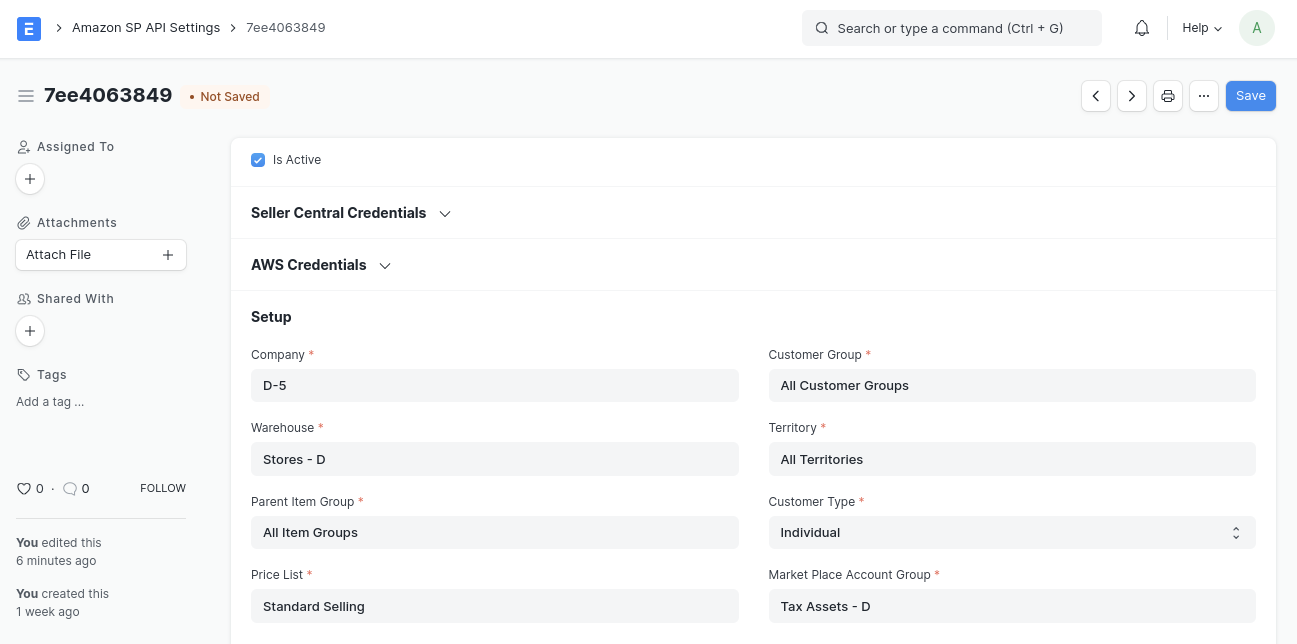Unlock a treasure trove of benefits by connecting ERPNext with Amazon Seller Central. This powerful setup helps you manage orders, inventory, customers, and invoices from one place. In this blog post, you'll learn how to connect seamlessly with eCommerce platforms using the Amazon ERPNext Connector powered by SP-API integration.
Let’s explore how to automate order processing, improve inventory accuracy, and simplify your financial reports. Whether you're a retailer, wholesaler, or private label seller, this integration can help you navigate the complexities of modern commerce.
Table of Contents
- ERPNext Integration With Amazon: Real-Time Sync, Automation & SP-API Setup
- Why Integrate ERPNext With Amazon?
- Key Features of ERPNext Amazon Integration
- Benefits of Amazon – ERPNext Integration
- How to Set Up Amazon SP-API Connector in ERPNext
- Best Practices for Maintaining Integration
- Common Challenges & How to Overcome Them
- Use Cases & Industry Applications
- Frequently Asked Questions (FAQs)
Why Integrate ERPNext With Amazon?
Managing your business through multiple tools can be messy. When you integrate ERPNext with Amazon, you consolidate operations and increase efficiency. You don’t have to switch between systems to check stock, create invoices, or track orders. Everything happens inside ERPNext with real-time data sync from Amazon.
This integration lets you keep all your sales, inventory, and customer data in one place. You’ll reduce errors, save time, and improve accuracy. It also simplifies tax and finance reporting since ERPNext tracks everything from customer and tax data import to account group for commissions automatically.
Key Features of ERPNext Amazon Integration
Real-Time Data Synchronization
With real-time visibility into inventory levels, ERPNext updates instantly when orders come in or stock changes. The system tracks pricing, customer info, and shipping data from Amazon without delay. You’ll always know what’s in stock and what’s running low.
Inventory & Warehouse Management
ERPNext(Open-Source ERP) helps you manage your own warehouses and FBA warehouse transfers too. Stock levels are updated for both your Amazon and ERPNext accounts. You can easily move inventory between locations and avoid overselling.
Auto-Generated Sales Invoices
No need to create invoices manually. ERPNext automatically makes sales invoices every time an Amazon order is placed. This saves you hours of manual work and ensures accuracy in your records.
Amazon-ERPNext Item Mapping
Each Amazon product listing can be matched to an ERPNext item. This Amazon item mapping ensures the right stock levels are updated and linked to the correct items in your system, supporting smooth payment + e-commerce integration.
Internal Transfers Between FBA Warehouses
Easily transfer inventory between different FBA warehouses using ERPNext. This supports your multi-location Amazon operations and gives you better control over your stock movement.
Automated Customer Creation
ERPNext uses Amazon orders to auto-create customer profiles. It pulls in names, shipping addresses, and contact info. This allows for personalised customer interactions without entering data manually.
Benefits of Amazon – ERPNext Integration
With this integration, your business becomes easier to manage. You can handle more orders and stock without hiring more people. It gives your team time to focus on growth, not manual tasks.
Here’s what else you gain:
| BenefitDescription | |
| Scalability | Drive growth and scalability by managing more SKUs without extra work |
| Visibility | Use real-time dashboards for fast insights |
| Efficiency | Cut down errors and speed up processing |
| Growth | Expand to new markets with synced systems |
You’ll no longer guess if a product is in stock or if a customer has been billed. ERPNext handles that with smart automation and centralised data management.
How to Set Up Amazon SP-API Connector in ERPNext

Step 1: Get Amazon Developer Credentials
To start, register as a developer in Amazon Seller Central. Once registered, you’ll get important keys:
- Client ID and secret
- AWS credentials (Access Key & Secret Key)
- IAM ARN
- Refresh token configuration
Keep these safe. You’ll need them for ERPNext setup.
Step 2: Configure ERPNext
In ERPNext, go to the Amazon Integration Settings section. Enter all the API credentials you collected. Then, set up your basic configuration:
- Your company info
- Price list configuration
- Main warehouse and item groups
- Territory and customer group setup
- Your account group for commissions
This ensures the system knows where to send and receive data.
Step 3: Activate the Integration
Now, toggle the “Is Active” switch to turn on the connection. Save the settings and begin syncing. ERPNext will now talk to Amazon, keeping your data up to date automatically.
Best Practices for Maintaining Integration
To avoid sync issues, follow these tips:
- Update your Amazon API keys regularly
- Check error logs in ERPNext weekly
- Run background jobs at night or during off-hours
- Test in sandbox mode before going live
Using these steps, you’ll keep your seamless data exchange running smoothly and avoid future breakdowns.
Common Challenges & How to Overcome Them
Duplicate Listings or Mismatches
Make sure the SKUs in Amazon match exactly with those in ERPNext. Wrong SKUs can cause sync issues and duplicate entries.
Incorrect Tax Configuration
Check if Amazon’s tax charges match your ERPNext tax settings. Use the right tax template to map every fee properly to the right repository for commissions and taxes.
API Rate Limits
Amazon’s API has limits. If you sync too often, it may stop working. Space your syncs using intervals to avoid this.
Use Cases & Industry Applications
Many businesses already use this modern commerce solution to scale faster. Here are real-world examples:
- Retailers with high-volume B2C orders automate fulfillment with ERPNext
- Wholesalers streamline bulk shipments and invoices
- Private label brands manage FBA inventory easily
- Omnichannel sellers sync Amazon, Shopify, and WooCommerce into one ERP
This helps them grow, cut costs, and offer better service.
Frequently Asked Questions (FAQs)
Q1: Is this integration available out-of-the-box in ERPNext?
No, you’ll need to use a custom Amazon ERPNext Connector or a third-party SP-API integration.
Q2: What permissions are required in Amazon Seller Central?
You need developer access, MWS or SP-API permissions, and your Amazon API keys from IAM.
Q3: Can I sync returns and refunds as well?
Yes. Amazon provides this data, and ERPNext will reflect it with proper item and financial mapping.
Q4: How often is data synced between ERPNext and Amazon?
You can set it to real-time or use batch syncing every 15 or 30 minutes.
Q5: Does this work with both FBA and FBM?
Yes. ERPNext supports both Fulfilled by Amazon (FBA) and Fulfilled by Merchant (FBM) workflows.

